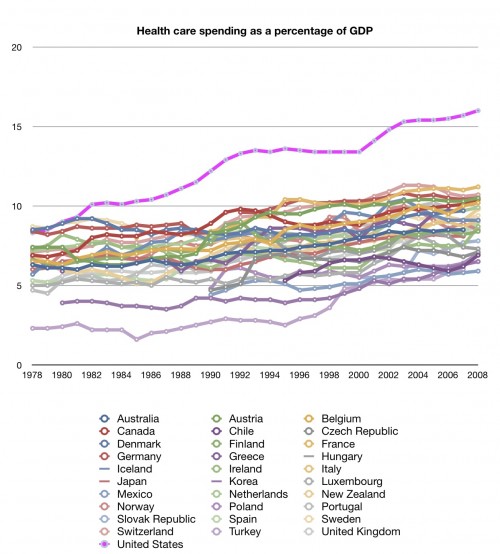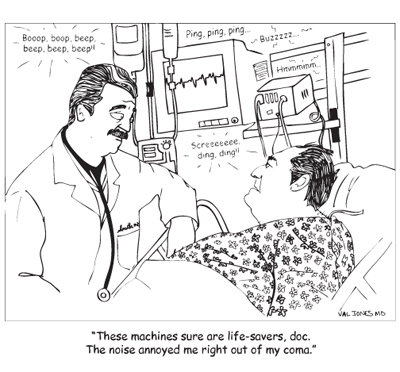September 13th, 2011 by Stanley Feld, M.D. in Health Policy, Opinion
No Comments »

Patients are first. Patients are the reason for the existence of the healthcare system. Physicians are second. They are trained to understand the pathophysiology of illness and to treat patients for their disease. Everyone else is a secondary stakeholder (provider).
All the stakeholders create waste in the healthcare system. If an accurate analysis were performed, most of the waste and the resulting profits would be attributed to the secondary stakeholders. Patient and physicians drive this waste and profits into the hands of the secondary stakeholders. Neither patients nor physicians are aware of driving the waste and profit into these stakeholders’ coffers.
The patient-physician relationship should be a one on one transaction. Patients and physicians are frustrated and many have accepted the disappearance of this human-to-human interaction.
Healthcare insurance companies and hospital systems think they own the patients and the physicians. This will turnout to be a fatal misperception.
To many observers of the healthcare system Read more »
*This blog post was originally published at Repairing the Healthcare System*
September 6th, 2011 by DrRich in Health Policy, Opinion
No Comments »

A recurring theme of the CRB is that the rising cost of healthcare is the main internal threat to the continued viability of the US. Indeed, the very title of this blog reflects the chief mechanism which is being employed, fruitlessly and disastrously, in the attempt to reduce those costs.
Recently, DrRich pointed out that there are four ways – and only four ways – to reduce the cost of healthcare. He did this as a service to his readers, so that when politicians describe in their weaselly language how they will get the cost of healthcare under control, you will be able to figure out which of the four methods they are actually talking about.
While DrRich’s synthesis has been generally well-received, a few readers did offer one particular objection. DrRich, they assert, left out a fifth way to reduce the cost of healthcare, and the very best way at that. Namely, just get rid of the waste and inefficiency.
DrRich has talked about this before, but obviously it is time to revisit the issue.
It is, in fact, a central assumption of any healthcare reform plan ever proposed that we can get our spending under control simply by eliminating – or at least substantially reducing – the vast amount of waste and inefficiency in the healthcare system. Conservatives propose to do this by Read more »
*This blog post was originally published at The Covert Rationing Blog*
August 27th, 2011 by Stanley Feld, M.D. in Health Policy, Opinion
2 Comments »

The Role of Physicians in Controlling Medical Care Costs and Reducing Waste by the RAND Corporation and David Geffen, University of California Los Angeles School of Medicine, Santa Monica was just published in the Journal of the American Medical Association (JAMA). I do not think the JAMA should have published this article.
1.Why would the JAMA publish such an article?
2. Why are physicians blamed for all the waste in the system?
3. Why is it the physicians’ responsibility to eliminate waste when they are not the cause of the greatest percentage of the waste?
“The amount of money spent on medical care is increasing faster than the gross domestic product (GDP), and the federal deficit is increasing.”
The initial statement assumes that the government deficit is increasing because physicians control government spending for healthcare.
This is only partly correct. Read more »
*This blog post was originally published at Repairing the Healthcare System*
October 11th, 2010 by Shadowfax in Better Health Network, Health Policy, Opinion, Research
No Comments »

Aaron Carroll over at The Incidental Economist has been running an excellent series on healthcare spending in the U.S. and how much more we spend than the rest of the world on a per capita basis, as a percentage of GDP, and by category. It’s an excellent series and I wholly recommend it. Summary graph:

Hint: the U.S. is the lavender-ish line on top. As he says, is there anything about this graph that isn’t concerning? Read more »
*This blog post was originally published at Movin' Meat*
June 14th, 2010 by Shadowfax in Health Policy, Opinion
No Comments »

This is something I haven’t seen reported on elsewhere, but according to the ACEP 911 Legislative Network Weekly Update, there was an interesting twist in the Democrats’ proposed SGR fix:
The latest plan increases physician payments by 1.3% for the remainder of this year and by an additional 1% in 2011. In 2012 and 2013, physician services would be separated into two categories, or “buckets.” One bucket would be for E&M services (including emergency department, primary and preventive care) and the other group would include all other services. The E&M bucket would increase at the same rate as the U.S. gross domestic product (GDP) plus 2%, while the other group would receive a payment increase of GDP plus 1%.After 2013, the payment formula would revert back to the current SGR formula, which means physicians would face cuts in the range of 30-35% unless Congress intervenes.
So it’s another temporary fix, kicking the can past the next presidential election. But it’s the first one I have seen that attempts to address the gross disparity in reimbursement for procedural services compared to the cognitive services. It bypasses the RUC and almost every other existing mechanism for determining reimbursement under the MPFS.
I’m not sure what happened with this proposal. I don’t think it was in the version of legislation the House passed, so I think it might be dead. But the situation is so in flux that who really knows? If nothing else, it’s an encouraging sign that policymakers know the problem exists and are willing to throw out possible solutions. This one may be dead, but it’s a good start.
*This blog post was originally published at Movin' Meat*















